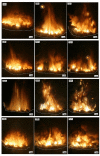Solid Propellant Formulations: A Review of Recent Progress and Utilized Components
- PMID: 34772180
- PMCID: PMC8587658
- DOI: 10.3390/ma14216657
Solid Propellant Formulations: A Review of Recent Progress and Utilized Components
Abstract
The latest developments in solid propellants and their components are summarized. Particular attention is given to emerging energetic binders and novel, 'green' oxidizing agents and their use in propellant formulations. A brief overview of the latest reports on fuel additives is included. Finally, a summary of the state of the art and challenges in its development are speculated on.
Keywords: GAP; binder; energetic material; green; propellant; solid propellant.
Conflict of interest statement
The authors declare no conflict of interest.
Figures











References
-
- Bozic V., Jankovski B. Chemical Rocket Propulsion. Springer; Cham, Switzerland: 2017. Some civilian applications of solid propellants; pp. 935–962. Springer Aerospace Technology. - DOI
-
- Folly P., Mäder P. Propellant chemistry. Chimia. 2004;58:374–382. doi: 10.2533/000942904777677713. - DOI
-
- Mason B.P., Roland C.M. Solid propellants. Rubber Chem. Technol. 2019;92:1–24. doi: 10.5254/rct.19.80456. - DOI
-
- Chaturvedi S., Dave P.N. Solid propellants: AP/HTPB composite propellants. Arab. J. Chem. 2019;12:2061–2068. doi: 10.1016/j.arabjc.2014.12.033. - DOI
-
- Xiao L.Q., Fan X.Z., Li J.Z., Qin Z., Fu X.L., Pang W.Q., Wang Y. Effect of Al content and particle size on the combustion of HMX-CMDB propellant. Combust. Flame. 2020;214:80–89. doi: 10.1016/j.combustflame.2019.12.022. - DOI
Publication types
Grants and funding
LinkOut - more resources
Full Text Sources
Miscellaneous

